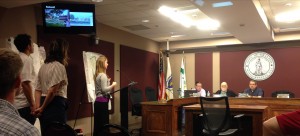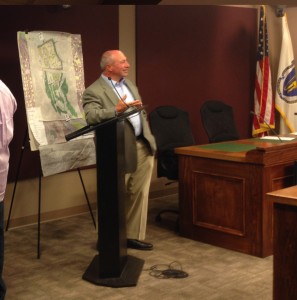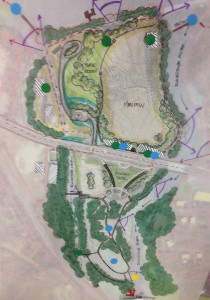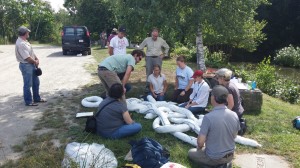By Jacquelyn Burmeister
On Monday, June 8th, students from the Conway School of Landscape Design joined members of the Grafton community for the Town Planning Meeting at Town Hall. Here, they presented their new design ideas for the Fisherville Mill Site as part of the “Creating a Teaching Landscape” project that was funded by the Blackstone River National Heritage Corridor last December.
Town Planner Joe Laydon began the meeting by introducing the project, briefly describing the long history that the Fisherville Mill site has had within the Town, and its recent funding from The Blackstone River Valley National Heritage Corridor for projects to make the site a replicable model for cross-disciplinary education and remediation throughout the region. One aspect of the project included the collaboration with students from the Conway School of Landscape Design to create a site vision that would highlight the dynamic landscape of the parcel. The students that developed the vision as their final consulting project, and had spent the majority of their final trimester at the Conway School working up to the town meeting.

Jillian Ferguson, Jeff Frisch and Hillary Collins of the Conway School present the culmination of their final semester’s work on the Fisherville Mill Site “Creating a Teaching Landscape” project.
From here, students Jillian Ferguson, Jeff Frisch and Hillary Collins walked the community through various visions of the site, highlighting and building upon the current nature, community and industry attractions of the land. Some potential future enhancements included creating a “ghost” of the old mill building, using old granite slabs at the site to draw an open-air outline of the building footprint, including remnants of the old factory gears and other large machinery. Also proposed was an amphitheater overseeing a new boat launch and dock on the Fisherville Pond, an upgrade to the current Eco-Machine, boardwalks and footpaths along the waterfront, and observation deck, shading for the Mill Villages Park, and a new design for the future mixed use development that the site hopes to ultimately construct. The idea is that each entity can stand as a discrete project that can be funded when the opportunity arises, so that the town can advance to the final vision at its own pace.

Site owner, Gene Bernat, talks about the positive impact that the remediated Fisherville Mill Site has already had on the community.
After describing the proposed enhancements, the students presented how these projects would appear within the bounds of the natural landscape of the site with two potential sketches. They invited community participation in the design of the final plan, using color-coded stickers to indicate how feasible each design aspect was. While Planning Board and community members filed up to get a closer look at the plans, Gene Bernat, the owner of the site, gave a few words about the larger vision of the Fisherville Mill project. “We want to create a place that people want to be; that highlights the natural and social history of the site, as well as the past and future science”, he said. The site has already received a lot of attention both inside the Grafton Community and internationally, for its community designed Mill Villages Park and the innovative way in which the Eco-Machine remediates the contaminated water of the Blackstone River. “The park vastly improved South Grafton”, continued Gene, “and now we have the potential to do so much more”.
One potential plan for the site, blue and green dots represent entities that were received well by the community.
The project was received with enthusiasm, and the plans displayed during the meeting were covered in dots representing positive remarks about the fixtures. With this feedback, the students at Conway will create their final proposal for the site.
If you would like to get a better look at the project plans, they will be on display at the Grafton Town Hall. More pictures will be available on the Living Systems Lab at the Fisherville Mill Facebook page, and space is provided for public comment.
Stay tuned for more information about this project!





